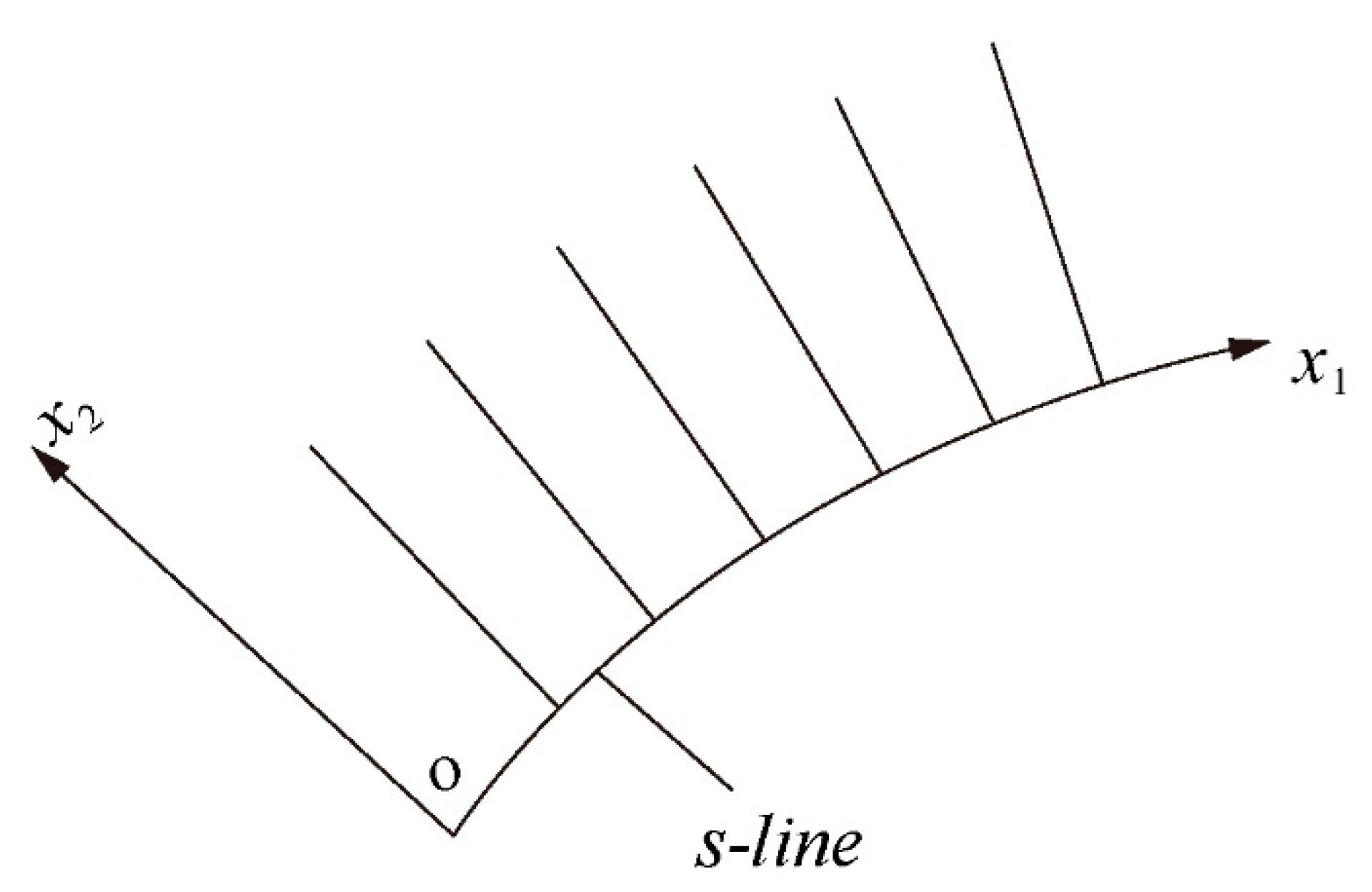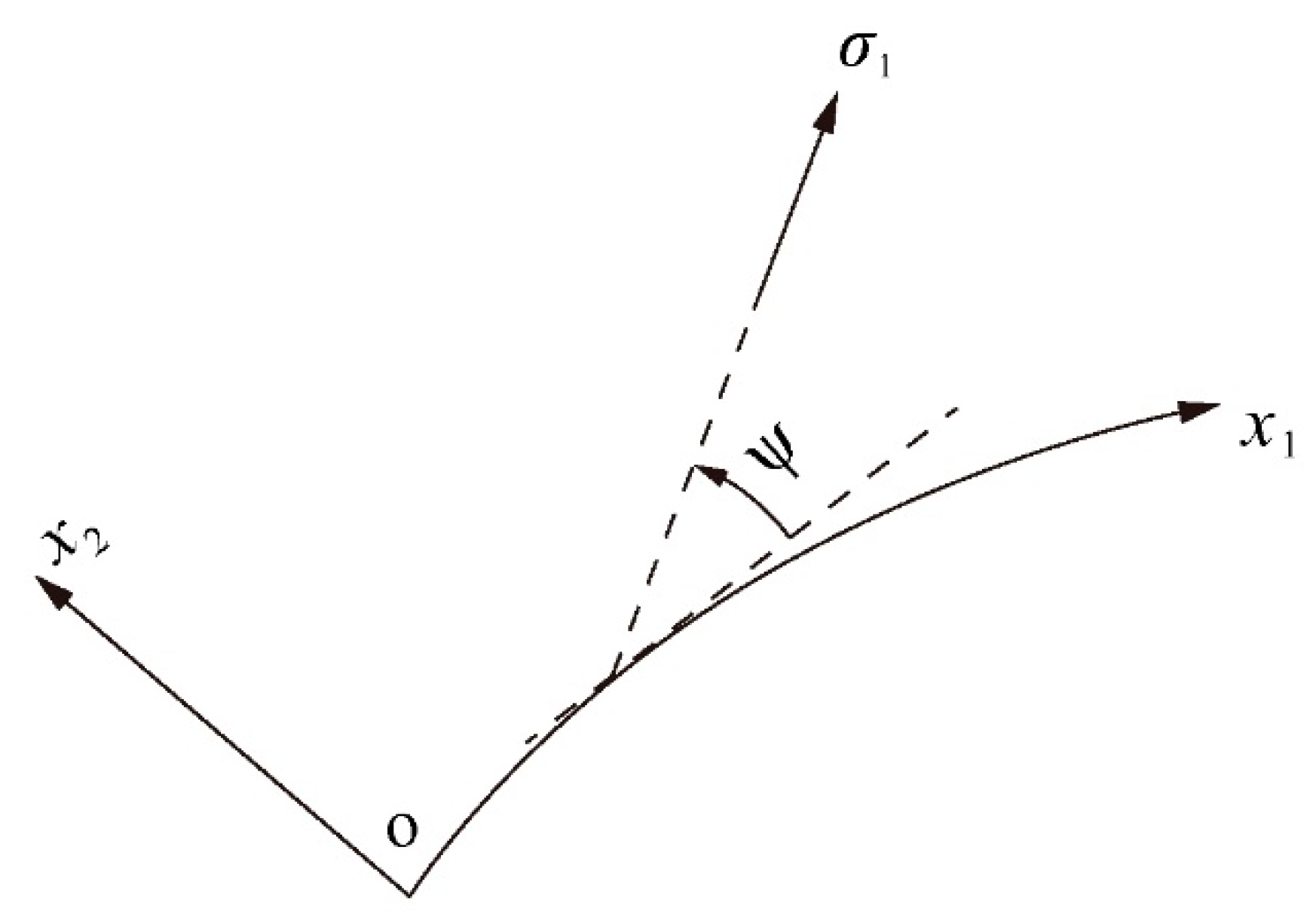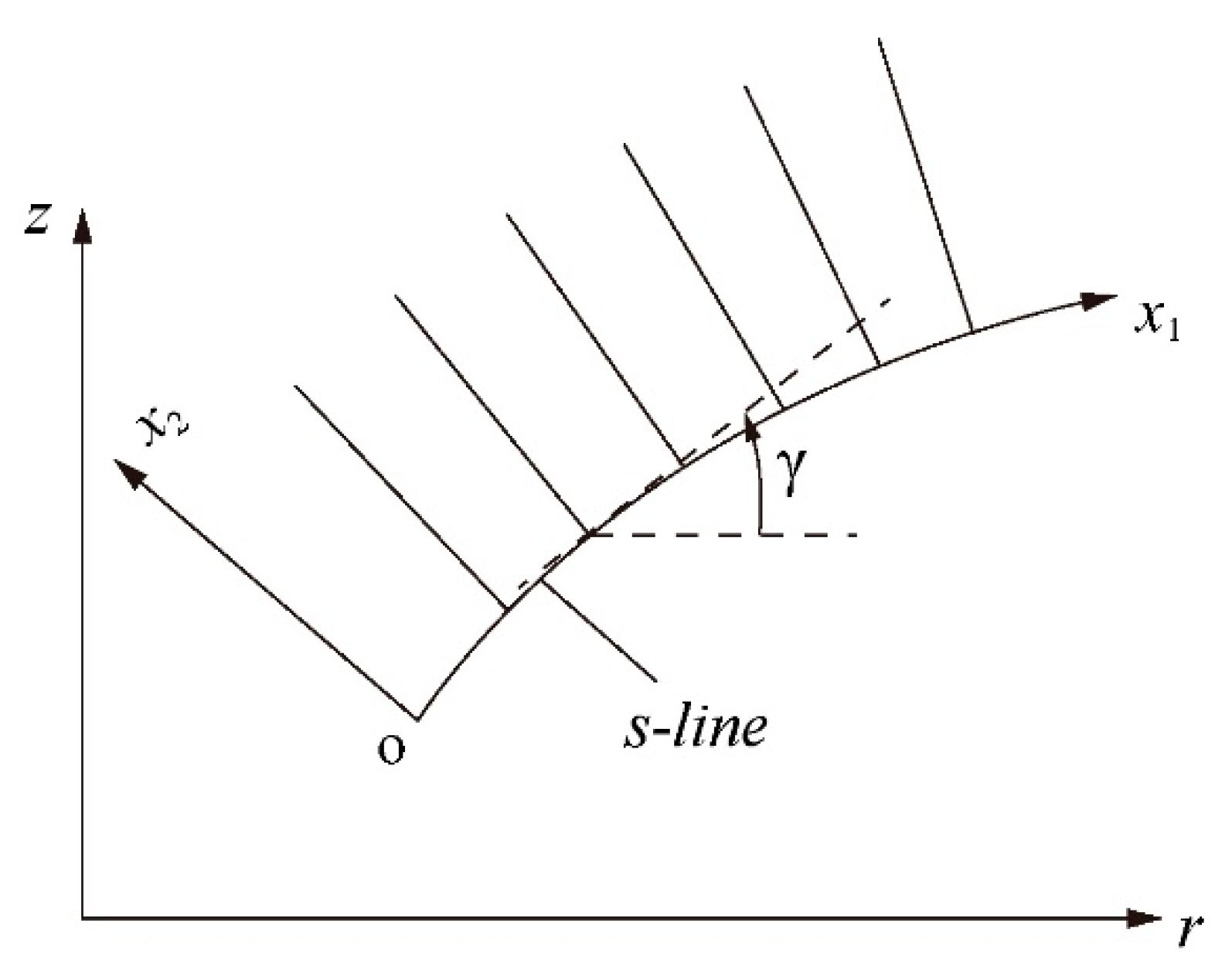Solution Behavior in the Vicinity of Characteristic Envelopes for the Double Slip and Rotation Model
Abstract
1. Introduction
2. Basic Equations
2.1. Plane Strain Deformation
2.2. Axisymmetric Deformation
3. Characteristic Analysis
3.1. Plane Strain Deformation
3.2. Axisymmetric Deformation
4. Asymptotic Analysis
4.1. Plane Strain Deformation
4.2. Axisymmetric Deformation.
5. Conclusions
Author Contributions
Funding
Conflicts of Interest
References
- Cox, G.M.; Thamwattana, N.; McCue, S.W.; Hill, J.M. Coulomb-Mohr granular materials: Quasi-static flows and the highly frictional limit. Appl. Mech. Rev. 2008, 61, 060802. [Google Scholar] [CrossRef]
- Goddard, J.D. Continuum modeling of granular media. Appl. Mech. Rev. 2014, 66, 050801. [Google Scholar] [CrossRef]
- Hui, K.; Haff, P.K.; Ungar, J.E.; Jackson, R. Boundary conditions for high-shear grain flows. J. Fluid Mech. 1984, 145, 223–233. [Google Scholar] [CrossRef]
- Gutt, G.M.; Haff, P.K. Boundary conditions on continuum theories of granular flow. Int. J. Multiph. Flow 1991, 17, 621–634. [Google Scholar] [CrossRef]
- Jenkins, J.T. Boundary conditions for rapid granular flow: Flat, frictional walls. J. Appl. Mech. 1992, 59, 120–127. [Google Scholar] [CrossRef]
- Savage, S.B.; Dai, R. Studies of granular shear flows: Wall slip velocities, “layering” and self-diffusion. Mech. Mater. 1993, 16, 225–238. [Google Scholar] [CrossRef]
- Zheng, X.M.; Hill, J.M. Boundary effects for Couette flow of granular materials: Dynamical modelling. Appl. Math. Model. 1996, 20, 82–92. [Google Scholar] [CrossRef]
- Ehsan, B.; Ali, N.; Shima, Z. A state boundary surface model for improving the dilatancy simulation of granular material in reinforced anchors. Arab. J. Geosci. 2017, 10, 281–293. [Google Scholar]
- Yang, L.; Padding, J.T.; Kuipers, J.A.M. Partial slip boundary conditions for collisional granular flows at flat frictional walls. AIChE J. 2017, 63, 1853–1871. [Google Scholar] [CrossRef]
- Sarno, L.; Carleo, L.; Papa, M.N.; Villani, P. Experimental investigation on the effects of the fixed boundaries in channelized dry granular flows. Rock Mech. Rock Eng. 2018, 51, 203–225. [Google Scholar] [CrossRef]
- Pemberton, C.S. Flow of imponderable granular materials in wedge-shaped channels. J. Mech. Phys. Solids 1965, 13, 351–360. [Google Scholar] [CrossRef]
- Marshall, E.A. The compression of a slab of ideal soil between rough plates. Acta Mech. 1967, 3, 82–92. [Google Scholar] [CrossRef]
- Spencer, A.J.M. Compression and shear of a layer of granular material. J. Eng. Math. 2005, 52, 251–264. [Google Scholar] [CrossRef]
- Spencer, A.J.M. A theory of the kinematics of ideal soils under plane strain conditions. J. Mech. Phys. Solids 1964, 2, 337–351. [Google Scholar] [CrossRef]
- Harris, D. A hyperbolic augmented elasto-plastic model for pressure-dependent yield. Acta Mech. 2014, 225, 2277–2299. [Google Scholar] [CrossRef]
- Alexandrov, S.; Harris, D. Comparison of solution behaviour for three models of pressure-dependent plasticity: A simple analytical example. Int. J. Mech. Sci. 2006, 48, 750–762. [Google Scholar] [CrossRef]
- Alexandrov, S.; Harris, D. An exact solution for a model of pressure-dependent plasticity in an un-steady plane strain process. Eur. J. Mech. A Solids 2014, 29, 966–975. [Google Scholar] [CrossRef]
- Alexandrov, S.; Richmond, O. Singular plastic flow fields near surfaces of maximum friction stress. Int. J. Non-Linear Mech. 2001, 36, 1–11. [Google Scholar] [CrossRef]
- Alexandrov, S.; Jeng, Y.R. Singular rigid/plastic solutions in anisotropic plasticity under plane strain conditions. Cont. Mech. 2013, 25, 685–689. [Google Scholar] [CrossRef]
- Alexandrov, S.; Lang, L.; Lyamina, E.; Date, P.P. Solution behavior near envelopes of characteristics for certain constitutive equations used in the mechanics of polymers. Materials 2019, 12, 2725. [Google Scholar] [CrossRef]
- Desai, C.S.; Zaman, M.M. Thin-layer element for interfaces and joints. Int. J. Numer. Anal. Methods 1984, 8, 19–43. [Google Scholar] [CrossRef]
- De Gennaro, V.; Frank, R. Elasto-plastic analysis of the interface behavior between granular media and structure. Comput. Geotech. 2002, 29, 547–572. [Google Scholar] [CrossRef]
- Liu, H.; Song, E.; Ling, H.I. Constitutive modeling of soil-structure interface through the concept of critical state soil mechanics. Mech. Res. Commun. 2006, 33, 515–531. [Google Scholar] [CrossRef]
- Gens, A.; Carol, I.; Alonso, E.E. An interface element formulation for the analysis of soil reinforcement interaction. Comput. Geotech. 1989, 7, 133–151. [Google Scholar] [CrossRef]
- Boulo, M. Basic features of soli structure interface behavior. Comput. Geotech. 1989, 7, 115–131. [Google Scholar] [CrossRef]
- Ghionna, V.H.; Mortara, G. An elastoplastic model for sand-structure interface behavior. Geotechnique 2002, 52, 41–50. [Google Scholar] [CrossRef]
- Kaliakin, V.N. Insight into deficiencies associated with commonly used zero-thickness interface elements. Comput. Geotech 1995, 17, 225–232. [Google Scholar] [CrossRef]
- Villard, P. Modelling of interface problems by the finite element method with considerable displacements. Comput. Geotech. 1996, 19, 23–45. [Google Scholar] [CrossRef]
- Fries, T.P.; Belytschko, T. The extended/generalized finite element method: An overview of the method and its applications. Int. J. Numer. Meth. Eng. 2010, 84, 253–304. [Google Scholar] [CrossRef]
- Malvern, L.E. Introduction to the Mechanics of a Continuous Medium; Prentice Hall: Englewood Cliffs, NJ, USA, 1969. [Google Scholar]
- Spencer, A.J.M. Deformation of ideal granular materials. In Mechanics of Solids, the Rodney Hill 60th Anniversary Volume; Hopkins, H.G., Sewell, M.J., Eds.; Pergamon Press: Oxford, UK, 1982; pp. 607–652. [Google Scholar]
- Chen, J.C.; Pan, C.; Rogue, C.M.O.L.; Wang, H.P. A Lagrangian reproducing kernel particle method for metal forming analysis. Comp. Mech. 1998, 22, 289–307. [Google Scholar] [CrossRef]
- Facchinetti, M.; Miszuris, W. Analysis of the maximum friction condition for green body forming in an ANSYS environment. J. Eur. Ceram. Soc. 2016, 36, 2295–2302. [Google Scholar] [CrossRef]
- Uesugi, M.; Kishida, H. Frictional resistance at yield between dry sand and mild steel. Soils Found. 1986, 26, 139–149. [Google Scholar] [CrossRef]
- Hu, L.; Pu, J.L. Testing and modeling of soil-structure interface. J. Geotech. Geoenviron. 2003, 120, 851–860. [Google Scholar] [CrossRef]




© 2020 by the authors. Licensee MDPI, Basel, Switzerland. This article is an open access article distributed under the terms and conditions of the Creative Commons Attribution (CC BY) license (http://creativecommons.org/licenses/by/4.0/).
Share and Cite
Wang, Y.; Alexandrov, S.; Lyamina, E. Solution Behavior in the Vicinity of Characteristic Envelopes for the Double Slip and Rotation Model. Appl. Sci. 2020, 10, 3220. https://doi.org/10.3390/app10093220
Wang Y, Alexandrov S, Lyamina E. Solution Behavior in the Vicinity of Characteristic Envelopes for the Double Slip and Rotation Model. Applied Sciences. 2020; 10(9):3220. https://doi.org/10.3390/app10093220
Chicago/Turabian StyleWang, Yao, Sergei Alexandrov, and Elena Lyamina. 2020. "Solution Behavior in the Vicinity of Characteristic Envelopes for the Double Slip and Rotation Model" Applied Sciences 10, no. 9: 3220. https://doi.org/10.3390/app10093220
APA StyleWang, Y., Alexandrov, S., & Lyamina, E. (2020). Solution Behavior in the Vicinity of Characteristic Envelopes for the Double Slip and Rotation Model. Applied Sciences, 10(9), 3220. https://doi.org/10.3390/app10093220




